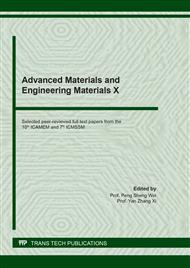[1]
Giuseppe E. Marcantoni, FROM MOLTEN METAL TO 3.2 mm WIRE FOR MECHANICAL APPLICATIONS, Light Metals 2012 Edited by: Carlos E. Suarez TMS (2012).
DOI: 10.1002/9781118359259.ch44
Google Scholar
[2]
C.M. Brocato, Properzi updates the CCR (Continuous Casting & Rolling) technology with new rolling stands, Proceedings of the 4th International Melt Qality Workshop, Istanbul Turkey (2008).
Google Scholar
[3]
Y. Otsuka, T. Nishikawa, Y. Yoshimoto, Y. Akasofu, Development of Aluminum Wire for Low-Voltage Automotive Wiring Harnesses, SAE Int. J. Passeng. Cars - Electron. Electr. Syst. 5(2012)486-491.
DOI: 10.4271/2012-01-0925
Google Scholar
[4]
M.G. Kim, Continuous Casting and Rolling for Aluminum Alloy Wire and Rod, Materials Science Forum, 638-642(2010)255-260.
DOI: 10.4028/www.scientific.net/msf.638-642.255
Google Scholar
[5]
M. Jabłoński, Effect of Iron Addition to Aluminium on the Structure and Properties of Wires Used for Electrical Purposes, Materials Science Forum, 690(2011)459-462.
DOI: 10.4028/www.scientific.net/msf.690.459
Google Scholar
[6]
K. Buxmann, E. Gold, Solidification Conditions and Microstructure in Continuously Cast Aluminum, Journal of Metals, 34(1982)28–34.
DOI: 10.1007/bf03337996
Google Scholar
[7]
N. Cheung, N. Santos, J. Quaresma, G. Dulikravich, A. Garcia, Interfacial heat transfer coefficients and solidification of an aluminum alloy in a rotary continuous caster, Int. J. Heat & Mass Transfer, 52(2009)451-459.
DOI: 10.1016/j.ijheatmasstransfer.2008.07.003
Google Scholar
[8]
D. Lewis, The Production Of Non-Ferrous Metal Slab And Bar By Continuous-Casting And Rolling Methods, Metallurgical Reviews, 6(1961) 143- 192.
DOI: 10.1179/mtlr.1961.6.1.143
Google Scholar
[9]
J. Birat, Continuous casting for tomorrow: Near-Net Shape Casting, Rev. Met. Paris, 86(1989) 317-334.
DOI: 10.1051/metal/198986040317
Google Scholar
[10]
Toshio Haga, Kohei Tuchitani, Hisaki Warari, Shinichi Nishida, Casting of Bar Using a Twin Wheel Caster, Key Engineering Materials, 831(2020)46-51.
DOI: 10.4028/www.scientific.net/kem.831.46
Google Scholar


